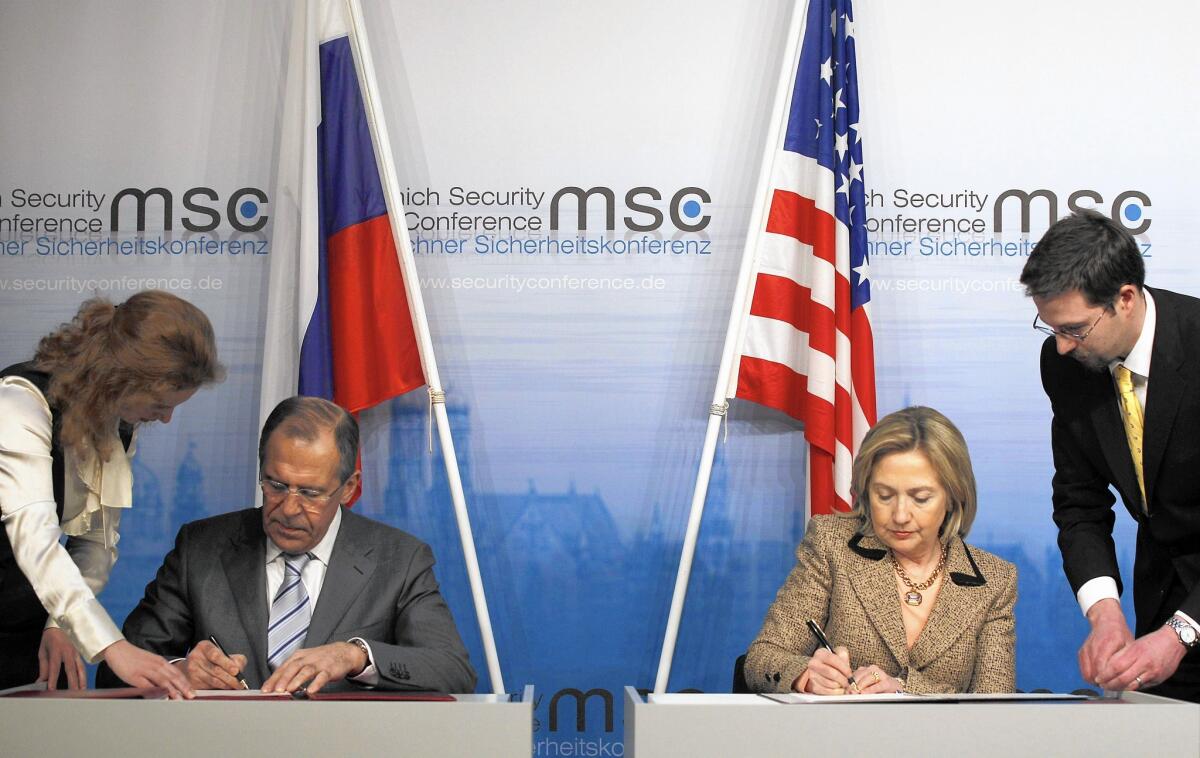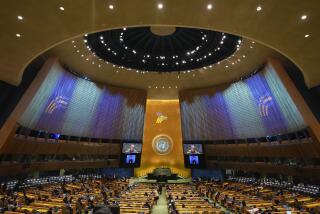Future of nuclear arms control looks bleak, experts say

- Share via
Reporting from WASHINGTON — The nuclear weapon treaties that have helped preserve peace for nearly half a century have begun to fray.
Stirring concern are recent Russian treaty violations, growing tensions between nuclear powers and the continuing ambitions of nations seeking their own strategic weapons.
The latest blow came with Russian President Vladimir Putin’s announcement last month that he would add 40 new intercontinental nuclear missiles to his arsenal — not a treaty violation, but a powerful message about Russia’s robust plans for its nuclear forces.
------------
FOR THE RECORD:
Nuclear treaties: A July 9 article in Section A on arms control incorrectly identified the R-500 as the missile that State Department officials said Russia tested in violation of a treaty. The department did not name a specific missile in its report.
------------
Over the last half-century, weapons treaties have led to a dramatic drop in the number of warheads. At the peak of the Cold War in the 1960s, the U.S. had more than 30,000 nuclear weapons — 400 targeted on Moscow alone.
Although both the U.S. and Russia are still below treaty limits set in the years after the dissolution of the Soviet Union, the prospect is growing dim for continued reductions in weapons.
The State Department recently concluded that Russia had violated a 1987 treaty by testing an intermediate-range missile — considered one of the most destabilizing weapons during the Cold War because of its ability to strike with no early warning.
The U.S. is now considering deploying its own medium-range missiles in Europe, a serious blow to the era of arms control.
“It might be unraveling,” said Siegfried Hecker, former director of the nuclear weapons design center at Los Alamos, N.M., and now a professor of management science and engineering at Stanford University.
Alexei G. Arbatov, a respected arms control expert and a former Russian legislator, agrees that the future for arms control appears bleak.
“Although arms control has faced difficulties in the past, never before have virtually all negotiating tracks been simultaneously stalled, existing treaties been eroded by political and technological developments, and the planning for next steps been so in doubt,” he wrote in a recent report published by the Carnegie Moscow Center.
Putin’s plan for 40 new missiles exacerbates the already tense relations between Russia and the U.S. following the seizure of Crimea and assistance to Ukrainian rebels. Putin boasted that the new missiles could penetrate even the most technologically advanced U.S. missile defense systems.
Some European and even U.S. analysts say Putin is merely updating his arsenal, just as the U.S. is planning to do with its forces over the next decade.
But the new missiles reverse years of nuclear weapons reductions, though they would not immediately violate the New Strategic Arms Reduction Treaty signed in 2010.
That agreement requires Russia and the U.S. to reduce deployed intercontinental missiles to 700 and overall warheads to 1,550 each. Russia is below the missile ceiling, while the U.S. is above it. Both sides are close to the limits on warheads. The two nations have until 2018 to meet the limits.
Still, U.S. Secretary of State John F. Kerry rejected any backsliding “to a kind of a Cold War status.”
“Nobody should hear that kind of announcement from a leader of a powerful country and not be concerned about what the implications are,” he said last month.
The U.S. and Soviet Union had begun to limit the arms race early in the Cold War, striking their first deal in 1963 to eliminate radioactive fallout from atmospheric tests.
About a dozen nuclear arms deals have been struck between the U.S., Russia and most other countries, according to Linton Brooks, who helped negotiate the first arms reduction treaty during the Reagan administration.
The most ambitious agreement, eventually signed by 190 nations, was the 1968 Non-Proliferation Treaty, which aimed to eventually eliminate nuclear weapons. Other agreements locked down or eliminated surplus inventories of weapons-grade uranium and plutonium to reduce the risk of nuclear terrorism.
But over recent years, cooperation began to break down as the views of nuclear weapons diverged between the U.S. and Russia.
The U.S. has come to see nuclear weapons as expensive, dangerous and militarily impractical.
“The U.S. is reducing the role of nuclear weapons in its national security doctrine, while Russia is increasing it,” Hecker said.
Russia considers itself surrounded by unfriendly neighbors — China to the southeast, Muslim republics in the southwest and North Atlantic Treaty Organization nations to the west — and it doesn’t have the conventional forces to handle the threats, said Stephen Rademaker, a former assistant secretary of State who helped implement the intermediate-range weapons treaty.
The result is that the intermediate-range treaty “is not going to be with us for the long term, because Russia wants out and evidently is taking concrete steps in anticipation of getting out,” Rademaker said. “We need to make sure when that day comes, we and our allies do not find ourselves at a disadvantage.”
The State Department has concluded Russia has violated the treaty by testing the R-500 intermediate-range cruise missile — the most serious breach of the accord signed in 1987 by President Reagan and Mikhail S. Gorbachev.
Earlier this month, the State Department issued an annual report that found that Russia violated a verification agreement and backed out of another agreement on nuclear cooperation.
In December, Russia also ended a 20-year program that helped stop nuclear materials from being stolen or sold on the black market.
Russian experts are also concerned about the loss of common ground. But they blame the U.S. because of its development of a long-range missile-defense system and precision long-range conventional weapons, even if they are intended to defend against rogue nuclear powers like North Korea and potentially Iran.
“The developments moved the U.S. and Russia far apart,” Arbatov said in an interview. “Unless those are dealt with, it will be very difficult to have future treaties.”
A future arms race among more than half a dozen nuclear powers could be more dangerous than even the Cold War, which largely revolved around the U.S. and Russia. The Non-Proliferation Treaty was supposed to prevent that problem, but it is under severe strain as a growing number of nations seek nuclear status.
At a monthlong treaty conference in New York this year, nonproliferation officials left United Nations headquarters empty-handed despite 125 impassioned speeches and thousands of documents filed to push toward eliminating the current 16,000 warheads.
They could not agree on a future meeting because of disagreements over a proposal to make the Middle East a nuclear-free zone. Such a goal would put Israel’s undeclared nuclear capability at issue.
No nation has loomed as a bigger threat to arms control than Iran. Six nations, including the U.S., are trying to negotiate a treaty to prevent Iran from becoming a nuclear power. An agreement was supposed to be reached last week, but Iran would not agree to future inspection requirements. Talks are continuing.
Proponents of the treaty say it would be an important step in controlling nuclear weapons. But critics say it is a destabilizing deal that would fuel a new arms race in the Middle East, cementing Iran in place as a threshold nuclear power. Critics point to a similar 1994 deal with North Korea that later fell apart, resulting in the country developing its own weapons.
Old hands of the Cold War say current tensions are unlikely to permanently thwart arms control.
“I think there is still the prospect for modest reductions in weapons,” said Philip E. Coyle III, former senior Obama national security advisor. “It will require a cooling of the rhetoric between the U.S. and Russia. It may have to wait until the next president.”
Rademaker also does not foresee another arms race, despite the turmoil over treaties.
“I don’t think there are fundamental conflicts between the U.S. and Russia that would get us into a war,” Rademaker said. “We are not in conflict over the future direction of the world, which we had during the Cold War.”
But the erosion in the nuclear treaties has created a momentum of its own.
The House Armed Services Committee has repeatedly tried to block implementation of New START because it reduces U.S. military readiness.
And Republican and Democratic defense experts have been pushing for heavy investments in developing new nuclear weapons.
The Obama administration began work last year on a proposed $355-billion plan to modernize U.S. nuclear forces.
Twitter: @wjhenn
Twitter: @rvartabedian
More to Read
Sign up for Essential California
The most important California stories and recommendations in your inbox every morning.
You may occasionally receive promotional content from the Los Angeles Times.












